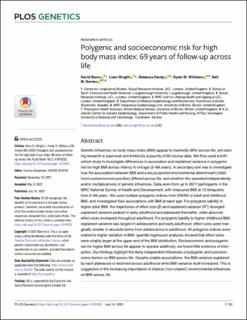| dc.contributor.author | Bann, David | |
| dc.contributor.author | Wright, Liam | |
| dc.contributor.author | Hardy, Rebecca | |
| dc.contributor.author | Williams, Dylan M. | |
| dc.contributor.author | Davies, Neil Martin | |
| dc.date.accessioned | 2023-03-03T07:56:30Z | |
| dc.date.available | 2023-03-03T07:56:30Z | |
| dc.date.created | 2022-08-16T18:57:27Z | |
| dc.date.issued | 2022 | |
| dc.identifier.citation | PLoS Genetics. 2022, 18 (7), e1010233-?. | en_US |
| dc.identifier.issn | 1553-7390 | |
| dc.identifier.uri | https://hdl.handle.net/11250/3055593 | |
| dc.description.abstract | Genetic influences on body mass index (BMI) appear to markedly differ across life, yet existing research is equivocal and limited by a paucity of life course data. We thus used a birth cohort study to investigate differences in association and explained variance in polygenic risk for high BMI across infancy to old age (2–69 years). A secondary aim was to investigate how the association between BMI and a key purported environmental determinant (childhood socioeconomic position) differed across life, and whether this operated independently and/or multiplicatively of genetic influences. Data were from up to 2677 participants in the MRC National Survey of Health and Development, with measured BMI at 12 timepoints from 2–69 years. We used multiple polygenic indices from GWAS of adult and childhood BMI, and investigated their associations with BMI at each age. For polygenic liability to higher adult BMI, the trajectories of effect size (β) and explained variance (R2) diverged: explained variance peaked in early adulthood and plateaued thereafter, while absolute effect sizes increased throughout adulthood. For polygenic liability to higher childhood BMI, explained variance was largest in adolescence and early adulthood; effect sizes were marginally smaller in absolute terms from adolescence to adulthood. All polygenic indices were related to higher variation in BMI; quantile regression analyses showed that effect sizes were sizably larger at the upper end of the BMI distribution. Socioeconomic and polygenic risk for higher BMI across life appear to operate additively; we found little evidence of interaction. Our findings highlight the likely independent influences of polygenic and socioeconomic factors on BMI across life. Despite sizable associations, the BMI variance explained by each plateaued or declined across adulthood while BMI variance itself increased. This is suggestive of the increasing importance of chance (‘non-shared’) environmental influences on BMI across life. | en_US |
| dc.language.iso | eng | en_US |
| dc.publisher | PLOS, Public Library of Science | en_US |
| dc.rights | Navngivelse 4.0 Internasjonal | * |
| dc.rights.uri | http://creativecommons.org/licenses/by/4.0/deed.no | * |
| dc.title | Polygenic and socioeconomic risk for high body mass index: 69 years of follow-up across life | en_US |
| dc.title.alternative | Polygenic and socioeconomic risk for high body mass index: 69 years of follow-up across life | en_US |
| dc.type | Peer reviewed | en_US |
| dc.type | Journal article | en_US |
| dc.description.version | publishedVersion | en_US |
| dc.source.volume | 18 | en_US |
| dc.source.journal | PLoS Genetics | en_US |
| dc.source.issue | 7 | en_US |
| dc.identifier.doi | 10.1371/journal.pgen.1010233 | |
| dc.identifier.cristin | 2043633 | |
| dc.source.articlenumber | e1010233 | en_US |
| cristin.ispublished | true | |
| cristin.fulltext | original | |
| cristin.qualitycode | 2 | |

